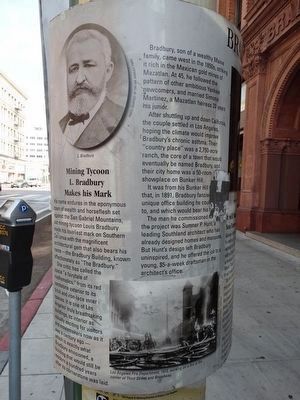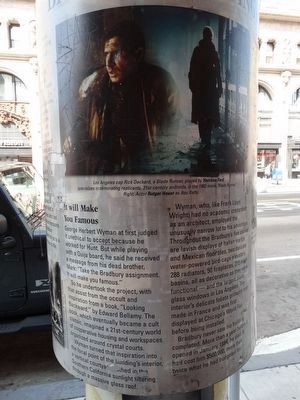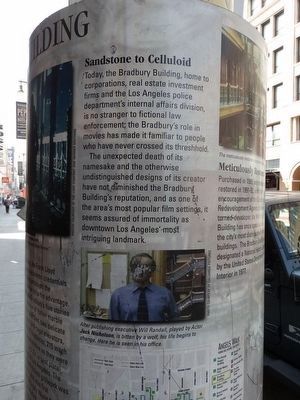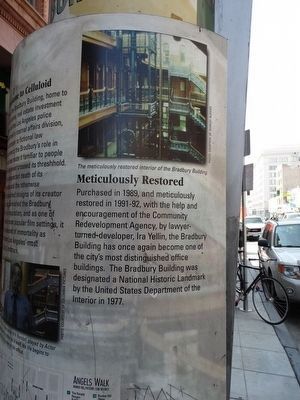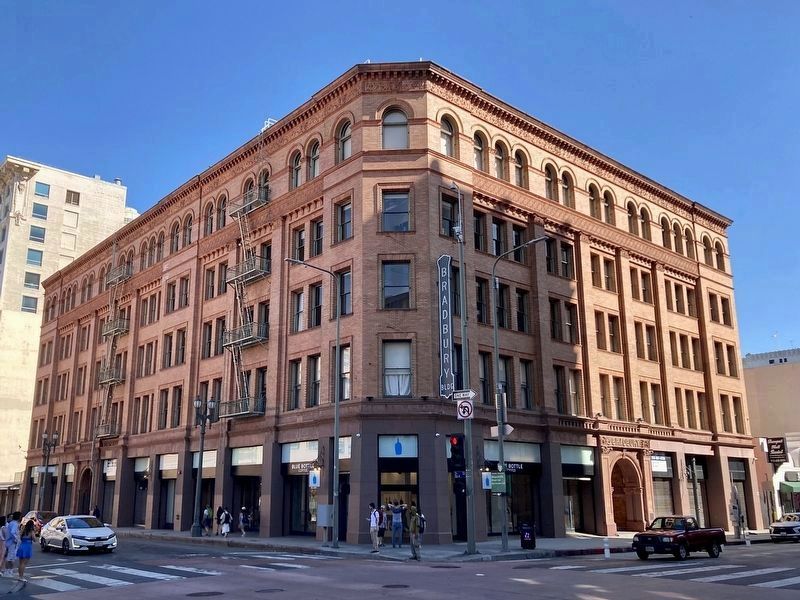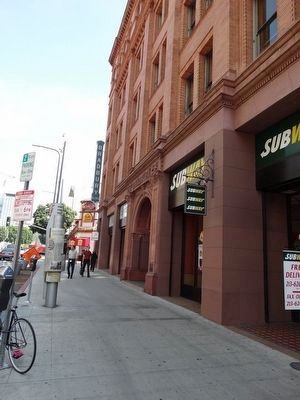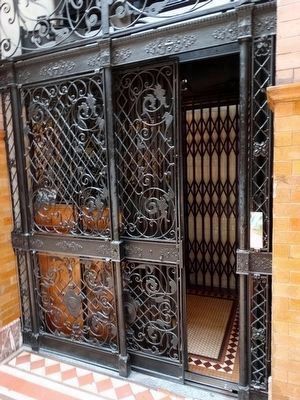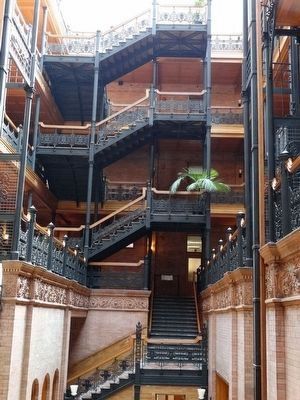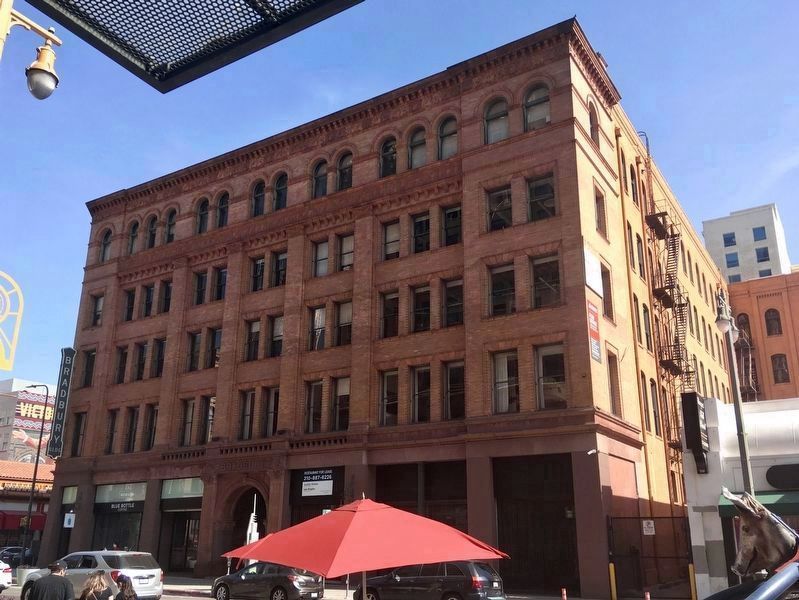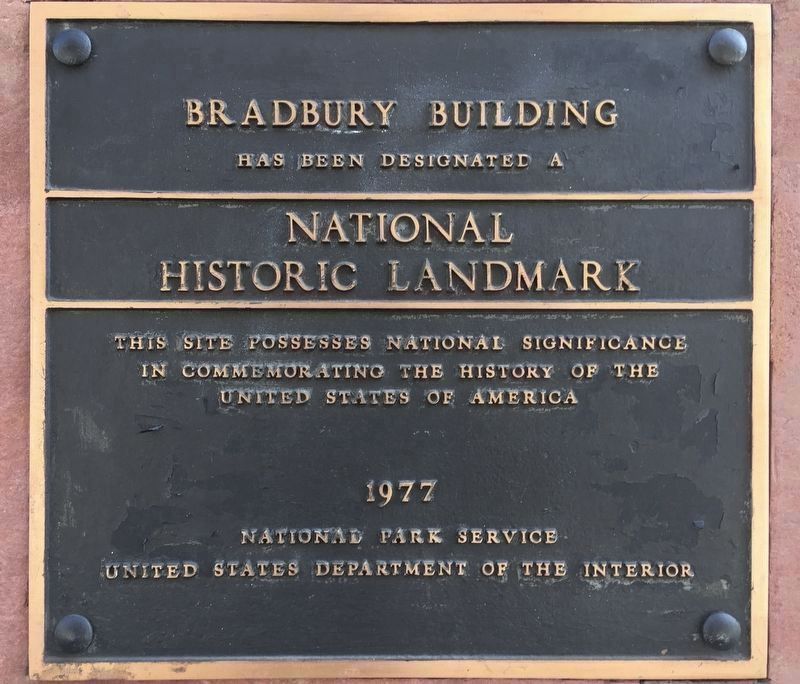Downtown Los Angeles in Los Angeles County, California — The American West (Pacific Coastal)
Bradbury Building
Inscription.
Mining Tycoon L. Bradbury Makes His Mark
His name endures in the eponymous town of wealth and horseflesh set against the San Gabriel Mountains, but mining tycoon Louis Bradbury made his loveliest mark on Southern California with the magnificent architectural gem that also bears his name – the Bradbury Building, known affectionately as “The Bradbury”.
One critic has called the space “a fairytale of mathematics,” from its red sandstone exterior to its brick and iron-lace inner spaces. It is one of Los Angeles' truly breathtaking buildings, its interior as visually exciting for visitors and moviemakers now as it was a century ago – which is exactly what Bradbury envisioned, a building that would still be modern a hundred years after its cornerstone was laid.
Bradbury, son of a wealthy Maine family, came west in the 1850s, striking it rich in the Mexican gold mines of Mazatlan. At 45, he followed the pattern of other ambitious Yankee newcomers, and married Simona Martinez, a Mazatlan heiress 20 years his junior.
After shuttling up and down California, the couple settled in Los Angeles, hoping the climate would improve Bradbury’s chronic asthma. Their “country place” was a 2,750-acre ranch, the core of a town that would eventually be named Bradbury, and their city home was a 50 room showplace on Bunker Hill.
It was from his Bunker Hill home that, in 1891, Bradbury fancied a unique office building he could walk to, and which would bear his name.
The man he commissioned for the project was Sumner P. Hunt, a leading Southland architect who had already designed homes and mansions. But Hunt’s design left Bradbury uninspired, and he offered the job to a young, $5-a-week draftsman in the architect’s office.
It Will Make You Famous
George Herbert Wyman at first judged it unethical to accept because he worked for Hunt. But while playing with a Ouija board, he said he received a message from his dead brother, Mark: “Take the Bradbury assignment. It will make you famous.”
So he undertook the project, with that assist from the occult and inspiration from a book, “Looking Backward,” by Edward Bellamy. The book, which eventually became a cult classic, imagined a 21st-century world of cooperative housing and workspaces organized around crystal courts.
Wyman turned that inspiration into the focal point of the building’s interior, a vertical courtyard bathed in the Southern California sunlight filtering through a massive glass roof.
Wyman, who like Frank Lloyd Wright, had no academic credentials as an architect, employed the unusually narrow lot to his advantage. Throughout the Bradbury’s five stories are lavish displays of Italian marble and Mexican floor tiles, two delicate water-powered bird-cage elevators, 288 radiators, 50 fireplaces, 215 wash basins, all as decorative as they were functional – and the largest plate glass windows in Los Angeles. The interior’s delicate foliate grillwork was made in France and was first displayed at Chicago’s World Fair before being installed.
Bradbury never saw his building completed. More than a year before it opened in January 1894, he died. It had cost him $500,000, more than twice what he had budgeted for.
Sandstone to Celluloid
Today, the Bradbury Building, home to corporations, real estate investment firms and the Los Angeles police department’s internal affairs division, is no stranger to fictional law enforcement; the Bradbury’s role in movies has made it familiar to people who have never crossed its threshold.
The unexpected death of its namesake and the otherwise undistinguished designs of its creator have not diminished the Bradbury Building’s reputation, and as one of the area’s most popular film settings, it seems assured of immortality as downtown Los Angeles most intriguing landmark.
Meticulously Restored
Purchased in 1989, and meticulously restored in 1991-92, with the help and encouragement of the Community Redevelopment Agency, by lawyer-turned developer, Ira Yellin, the Bradbury Building has once again become one of the city’s most distinguished office buildings. The Bradbury Building was designated a National Historic Landmark by the United States Department of the Interior in 1977.
Erected by The City of Los Angeles. (Marker Number 6.)
Topics and series. This historical marker is listed in this topic list: Architecture. In addition, it is included in the Los Angeles Historic-Cultural Monument, and the National Historic Landmarks series lists. A significant historical year for this entry is 1891.
Location. 34° 3.043′ N, 118° 14.884′ W. Marker is in Los Angeles, California, in Los Angeles County. It is in Downtown Los Angeles. Marker is at the intersection of Broadway and 3rd Street, on the left when traveling south on Broadway. Touch for map. Marker is at or near this postal address: 304 S Broadway, Los Angeles CA 90013, United States of America. Touch for directions.
Other nearby markers. At least 8 other markers are within walking distance of this marker. Million Dollar Theatre / Grand Central Market (within shouting distance of this marker); Irvine-Byrne Building (within shouting distance of this marker); Biddy Mason (about 300 feet away, measured in a direct line); Douglas Building (about 400 feet away); Spring Street (about 400 feet away); Angels Flight (about 600 feet away); Angels Flight Railway (about 600 feet away); a different marker also named Angels Flight (approx. 0.2 miles away). Touch for a list and map of all markers in Los Angeles.
Regarding Bradbury Building. The Bradbury Building is Los Angeles Historic-Cultural Monument No. 6, designated in 1962; it was added to the National Register of Historic Places in 1971; and designated a National Historic Landmark in 1977.
Also see . . .
1. This Building Is the Biggest Architectural Movie Star in Los Angeles. (Submitted on February 17, 2016.)
2. Angels Walk L.A. Self-guided walking tours of historic neighborhoods in Los Angeles. The Bradbury Building marker is part of the Bunker Hill walk. (Submitted on August 3, 2018, by Craig Baker of Sylmar, California.)
Credits. This page was last revised on July 7, 2023. It was originally submitted on February 7, 2016. This page has been viewed 832 times since then and 49 times this year. Last updated on March 1, 2021. Photos: 1, 2, 3, 4. submitted on February 7, 2016, by Denise Boose of Tehachapi, California. 5. submitted on July 5, 2023, by Craig Baker of Sylmar, California. 6. submitted on February 7, 2016, by Denise Boose of Tehachapi, California. 7, 8. submitted on February 21, 2016, by Denise Boose of Tehachapi, California. 9, 10. submitted on March 1, 2021, by Craig Baker of Sylmar, California. • J. Makali Bruton was the editor who published this page.
